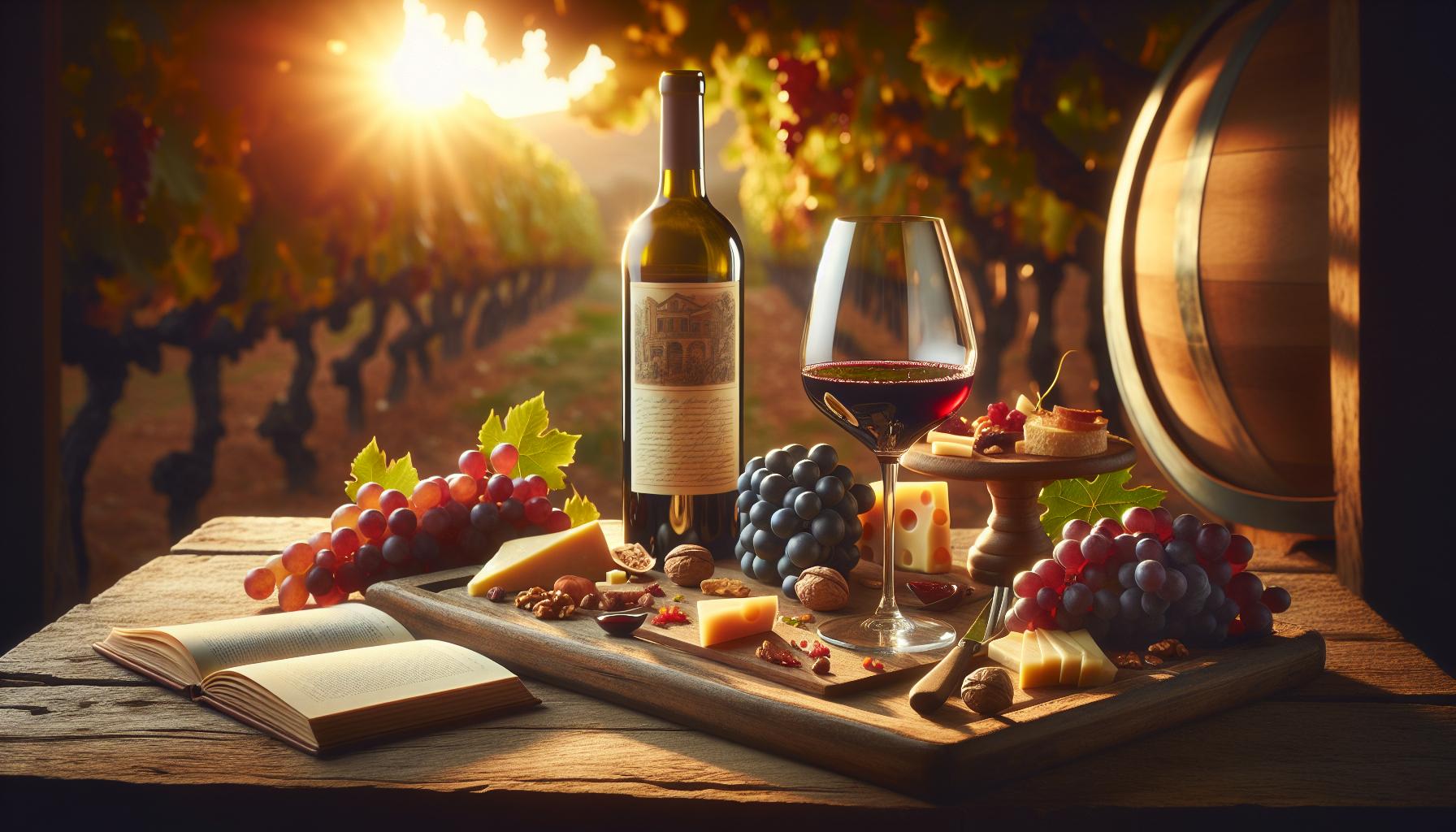Imagine the delicate dance of flavors that can transform a simple dessert into an extraordinary experience-this is the allure of dessert wine. Defined by its rich sweetness and vibrant character, dessert wine offers an indulgent pairing for evening treats, enhancing the flavors of cakes, cheeses, and fruits.
Whether you’re savoring a decadent chocolate cake or a zesty fruit tart, knowing which dessert wine to choose can elevate your culinary adventure. Many people assume that dessert wines are merely for sweet endings, but they hold the key to unlocking an array of flavor combinations that delight the senses. Join us as we explore the various styles of dessert wine and their perfect pairings, inviting you to connect more deeply with each sip and savor the stories they tell. Your palate awaits an exquisite exploration, promising to transform your dessert moments into cherished memories.
What Defines Dessert Wine? Understanding the Basics
Dessert wine embodies an enchanting world of flavors, crafted for the sweetest moments in life. Derived from grapes that embody high sugars and unique processing techniques, these wines boast a delightful spectrum of sweetness levels, styles, and aromas. Understanding what defines dessert wine begins with recognizing its primary characteristic: sweetness. This sweetness can originate from various methods, including late harvesting, noble rot (Botrytis cinerea), or fortification, each producing distinct profiles that dance beautifully on the palate.
Many people find themselves drawn to dessert wines not just for their sweetness but also for their complexity and ability to pair with a variety of dishes. From the luscious richness of a late-harvest Riesling to the bold intricacies of a fine Sauternes, these wines showcase an impressive range of flavors, often reflecting the terroir of their origins. The allure of dessert wine is not merely its sugar content but also its potential to evoke emotions and memories, making every sip an invitation to a moment suspended in time.
Moreover, the world of dessert wine extends far beyond what one might initially think. It invites exploration into various regions well-regarded for their production techniques, each with its own heritage and story. For instance, ice wine from Germany or Canada carries a delectable icy freshness, while Port, from Portugal, showcases depth and robust flavors, often infused with hints of spice and dried fruits. Each glass tells a tale, enriching our gastronomic experiences and providing a wonderful gateway to explore culture and tradition through the sweet, rich world of dessert wines.
Exploring Indulgent Styles of Dessert Wine
Dessert wine embodies a rich tapestry of indulgence that enchants the senses and elevates the experience of sweet moments. Among the myriad styles available, each presents a unique narrative, waiting to be explored. For instance, the opulent Sauternes, hailing from France, is crafted through the meticulous hand-selection of grapes affected by noble rot, which concentrates their sugars and flavors. This wine offers luscious notes of peach, apricot, and honey that glide smoothly across the palate, making it a divine companion for foie gras or a slice of blue cheese.
Another showstopper is Tokaji Aszú, a traditional Hungarian treasure. Its signature sweetness arises from the botrytized grapes often harvested late in the season, creating profound complexity with hints of orange zest, apricot, and a delightful minerality. Paired with a rich dessert like a chocolate torte, the contrasting flavors become a symphony of taste, where the wine’s acidity cuts through the sweetness, elevating every mouthful.
Plunge further into indulgent styles with Ice Wine. Originating from grapes harvested while frozen on the vine, primarily in regions like Germany and Canada, Ice Wine is bursting with concentrated fruit flavors-think luscious ripe mango or tropical pineapple-with a refreshingly crisp finish. It presents an exquisite match for fruit-forward desserts, such as a lemon tart or a fruit salad, creating a jubilant interplay of freshness and sweetness.
Don’t overlook the world of Port, particularly its rich and sumptuous late-bottled vintage varieties. This fortified wine, crafted in the Douro Valley of Portugal, is notable for its velvety texture and complex notes of dark chocolate, fig, and spices. It brilliantly accompanies desserts with a rich profile, such as a pecan pie or an assortment of chocolate desserts, offering a depth of flavor that invites lingering appreciation.
Every sip of dessert wine tells a story, transcending mere sweetness to evoke deeper cultural connections and personal reflections. Whether you are tasting a carefully aged Madeira or a vibrant Moscato d’Asti, the exploration of these indulgent styles invites not only flavor discovery but also a shared experience that connects us through the palate. So, as you savor each glass, take a moment to appreciate the craftsmanship and passion behind these wines, knowing they are crafted to enhance not just dessert, but the tapestry of life itself.
Pairing Dessert Wines with Delightful Dishes
Indulging in dessert wines is akin to unfolding the sweetest storybook; each sip delivers rich passages of flavor that intertwine beautifully with a variety of desserts. The art of pairing dessert wines with sweet dishes not only enhances the taste experience but also crafts memorable moments. When selecting a dessert wine, consider the sweetness level, acidity, and flavor profile of both the wine and the dish, allowing these elements to harmonize rather than clash. A well-thought-out pairing creates a dialogue between the dessert and the wine, transforming each bite and sip into a celebration of taste.
Take, for example, the captivating dance between a late-harvest Riesling and a slice of tarte Tatin. The wine’s natural sweetness, often accented by flavors of honey and stone fruits, beautifully complements the caramelized apples and buttery pastry of the tart. The acidity in the Riesling cuts through the richness of the dessert, cleansing the palate and inviting another delicious bite. Similarly, a glass of Moscato d’Asti, with its low alcohol content and vibrant effervescence, plays wonderfully against a light panna cotta, the floral notes elevating the delicate creaminess of the dish.
Popular Pairings to Explore
- Chocolate Desserts: Pair rich chocolate mousse with a luscious Banyuls or a bold Port, where the deep flavors of dark fruit and cocoa merge seamlessly.
- Fruit Pastries: For fruit tarts or berry crostata, a sparkling dessert wine like Asti or a sweet Chenin Blanc can enhance the fresh, fruity notes and add a refreshing contrast.
- Creamy Treats: Opt for a rich Chardonnay, either oaked or un-oaked, served alongside crème brûlée; the interplay between the wine’s buttery notes and the caramelized sugar crust is simply divine.
Beyond taste, consider the emotional and cultural resonance of each pairing. Wine serves as a vessel of history, tradition, and personal connection. As you sip a sweet Pedro Ximénez alongside a rich chocolate cake, reflect on the meticulous cultivation and aging of the grapes that has created such a profound flavor. Each element can stir nostalgia or inspire new memories, deepening the appreciation for both the dessert and the wine.
Engaging in the exploration of dessert wine pairings invites a playful curiosity, encouraging you to experiment and discover what resonates with your palate. Listen closely to the whispers of flavor, as they come together to weave a tapestry of indulgence that captivates the senses and warms the heart. Whether hosting a gathering or treating yourself to an intimate night in, the right dessert wine can elevate your culinary experience into something truly transcendent.
The Art of Sipping: Tasting Notes & Flavor Profiles
Sipping a dessert wine can evoke a sense of divine indulgence, akin to wrapping yourself in a warm blanket on a chilly evening, each taste unfolding layers of elegance and complexity. These wines, often characterized by their rich sweetness and diverse flavor profiles, invite a contemplative approach to sipping. Engaging fully with dessert wines can transform a simple pleasure into a sensory journey, allowing you to discover the nuanced storytelling woven into each bottle.
When exploring tasting notes, one encounters a tapestry of aromatic delights that can range from luscious honey and ripe stone fruits to alluring spices and chocolatey depths. A late-harvest Riesling, for example, often reveals a bouquet of apricot and jasmine, leading to a palate that dances between luscious sweetness and vibrant acidity. In contrast, a Pedro Ximénez showcases a rich, syrupy texture, filled with indulgent notes of dried figs, chocolate, and molasses, each sip reminiscent of a sumptuous dessert itself. Understanding these subtleties is key; the air should flow through your glass like a gentle breeze as you take in the aromas, transporting you into the world of the winemaker’s intention.
As you savor a deep, aromatic dessert wine, consider the interplay between sweetness and acidity. For instance, the balanced profile of a Sauternes with its honeyed richness and refreshing acidity can complement anything from a rich cheesecake to a delicate fruit tart, enhancing the experiential nature of both the wine and the dish. This balance is not merely a technical detail, but a harmonious conversation between flavors, inviting you to explore how different elements within the glass resonate with each other as well as with your palate. Discovering these combinations is akin to finding hidden gems, revealing unique dimensions in a familiar landscape.
Ultimately, embracing the art of sipping dessert wines is about more than tasting; it’s an invitation to slow down, explore, and connect with the stories that every bottle tells. Whether you choose to indulge on a quiet evening or share the experience with friends, allow yourself to be swept away by the complexity and ambrosial qualities that these wines bestow. Each sip, each moment, can craft a narrative of sublime indulgence, transforming your engagement with dessert wines into a celebration of life’s sweeter pleasures.
Regions Renowned for Dessert Wine Production
Throughout the world, certain regions have become synonymous with the production of exceptional dessert wines, each bringing its unique terroir, climate, and grape varieties into play. Journeying through these renowned locations reveals not just the exquisite flavors embedded in each bottle, but also the rich cultural narratives that define them.
One of the most illustrious is Bordeaux, France, particularly noted for its opulent Sauternes. This enchanting region is famed for its noble rot (Botrytis cinerea), which concentrates the sweetness and flavor of the grapes, primarily Sémillon. The resulting wines present an extraordinary complexity with notes of honey, apricots, and exotic spices. Not far from Bordeaux, regions such as Alsace also create stunning late-harvest Rieslings, whose floral aromas and high acidity balance beautifully with their natural sweetness, captivating the hearts of wine enthusiasts.
Across the Mediterranean, Italy offers a plethora of dessert wines. From the sun-drenched vineyards of Tuscany, where Vin Santo is made from dried grapes, to the northern Piedmont region, renowned for its luscious Passito wines, the country’s dedication to dessert wine is profound. Each bottle tells the story of its land-a passage through time and tradition that transforms simple grapes into sultry sips of heaven, invoking seasonal gatherings and festive celebrations.
In the New World, areas like California’s Napa Valley have embraced dessert wine production with fervor. The unique climatic conditions allow for the cultivation of a range of sweet wines, from vibrant Muscats to robust dessert blends. Here, winemakers blend artisanal techniques with innovative approaches, delighting palates and pushing the boundaries of traditional dessert wine styles.
Exploring these regions offers a sensory passport into diverse cultures, histories, and innovations in winemaking. A glass of Sauternes can whisk you away to sun-dappled vineyards basking under hazy skies, while a taste of Vin Santo brings to life cozy Italian evenings filled with laughter. A fuller appreciation of these wines not only elevates your tasting experience but also connects you to the very essence of their locales, crafting a richly woven tapestry of tradition and pleasure.
The Role of Sweetness: Understanding Wine Classification
The enchanting world of dessert wine is intricately woven with the multifaceted nature of sweetness, which plays a pivotal role in classifying these indulgent beverages. At its essence, sweetness in wine is derived from the natural sugars present in the grapes, and its level can significantly dictate the wine’s character, pairing potential, and overall enjoyment. The classification of dessert wines is generally based on sweetness levels, which can range from lightly sweet to rich and syrupy, all of which dance delightfully across the palate.
Understanding this classification begins with the recognition of two primary types of sweetness: residual and added. Residual sweetness occurs when the natural sugars from the grapes remain unfermented, creating wines that retain their fruity character. This can often be found in wines like Moscato or late-harvest Rieslings, where the charm lies in a balanced sweetness, vibrant acidity, and aromatic complexity. On the other hand, various fortified wines, such as Port or Sherry, achieve sweetness through the addition of grape spirits, a method that halts fermentation and preserves a high sugar content.
When considering dessert wines, it’s also essential to navigate through defining styles. Each category brings unique degrees of sweetness and wine-making techniques that contribute to its flavor and aromatic profile. Here are a few noteworthy types:
- Sparkling Sweet Wines: Such as Asti Spumante, these wines are celebrated for their effervescence and sweetness, resembling a delightful, bubbly celebration in a glass.
- Rich & Sweet Wines: Think Sauternes or Tokaji, where the concentration of sugars leads to an incredibly luscious and complex experience, often with notes of honey, apricot, and spices.
- Sweet Red Wines: Many Italian wines like Brachetto or Passito are crafted from dried grapes, offering a wonderfully aromatic sweetness that pairs beautifully with chocolate desserts.
- Fortified Wines: These wines, including Madeira and certain styles of Sherry, are crafted to enhance sweetness while preserving structure and depth.
As you contemplate the sweet spectrum of dessert wines, remember that preferences can be highly subjective. What may be deemed overly sweet by one palate can be an ethereal pleasure for another. The journey through sweetness in dessert wine is not merely about cloying sugar; it’s about discovering the intricate balance between sweetness, acidity, and flavor that each unique bottle can offer. So, indulge your curiosity and allow your taste buds to wander through the rich landscape of dessert wines, where each sip tells a story and creates a memory, enticing you to reflect, enjoy, and savor the sweet moments of life.
Crafting Your Perfect Dessert Wine Experience
Crafting an enthralling dessert wine experience can feel like an art form, where each sip serves not only to tantalize the palate but also to evoke memories and passions that transcend the moment. Picture yourself lingering over a delicate glass of late-harvest Riesling, its honeyed sweetness dancing with vibrant acidity, bringing forth recollections of sun-drenched afternoons spent among fragrant vineyards. The act of wine tasting becomes a celebration-a harmonious exploration of flavor, texture, and emotion.
To begin your journey, it’s essential to consider personal preferences. Are you drawn to the effervescence of sparkling sweet wines like Asti Spumante, or do the rich, syrupy notes of a Sauternes enchant you? Understanding what captivates your senses will guide you in selecting the right bottle. Don’t hesitate to experiment; the beauty of dessert wines lies in their diverse styles, from the approachable sweetness of Moscato to the opulent complexity of a vintage Port.
Equally vital is the role of temperature in enhancing your wine experience. Many dessert wines, particularly those with pronounced sweetness, benefit from being served chilled, generally around 45-55°F (7-13°C). This slight chill accentuates their refreshing qualities while balancing the sweetness, allowing the flavors to unfold gracefully on the palate. As you pour, take a moment to appreciate the wine’s color, clarity, and the delicate aromas wafting upwards-this initial sensory exploration lays the groundwork for what’s to come.
Food pairing transforms a simple tasting into a culinary masterpiece. Consider the interplay between the dessert and wine-perhaps a slice of creamy cheesecake pairs impeccably with a shimmering Moscato, or a rich chocolate torte is perfectly complemented by a glass of tawny Port. The complexity of flavors can elevate both the dessert and wine, providing a symphony of taste that lingers long after the last sip. Engage your friends or loved ones in this experience, sharing not just the wine but the stories and emotions each bottle evokes. By fostering a communal atmosphere, you create a memorable bonding experience that celebrates the simple joys and intricacies of life through the lens of dessert wine.
In essence, is about exploration, joy, and connection. Allow your tastes to guide you, embrace the process, and relish the flavors that linger in your memory long after the last drop has been savored. Each glass opened is not merely a beverage consumed but an invitation to indulge in the rich tapestry of life’s sweet moments.
Cultivating a Love for Dessert Wines: Tips for Newcomers
The world of dessert wines offers an enchanting exploration for newcomers, where sweetness is not merely a taste but a gateway to sensory delight and cultural richness. Imagine a chilled glass of Moscato sparkling under summer sunlight, its sweet effervescence mirroring the joy of the season. This is the beauty of dessert wines-they invite you to indulge in life’s sweeter moments while igniting your curiosity about the complexities of flavor.
To embark on this delightful journey, start by experimenting with different styles and varieties. Dessert wines come in an array of profiles, from the luscious richness of Sauternes to the zesty brightness of Riesling. Consider beginning with lighter options, such as a fruity Moscato or a sweet Riesling, which are generally more approachable for novices. As your palate develops, delve deeper into richer selections like Port or late-harvest wines, which offer intricate layers of flavor and history.
Building Your Palate
One of the joys of wine tasting is savoring the journey of discovery. Take notes on what stands out to you: Is it the delicate floral notes of a Gewürztraminer? Or perhaps the creamy caramel undertones of a Vin Santo? Engaging in this practice can deepen your appreciation and help refine your tastes over time. Don’t hesitate to visit local wine shops or attend tastings, where knowledgeable staff can provide insights and recommendations tailored to your preferences.
Pairing with Food
Nothing elevates the experience of dessert wine quite like the perfect pairing. Think about how contrasting or complementary flavors can create a richer experience. For example, pairing a sweet dessert wine like late-harvest Riesling with a tangy cheesecake creates a delightful balance. Alternatively, try a chocolate-covered dessert with a rich Port; the interplay of flavors can transform a simple evening into a culinary celebration. Sharing these moments with friends and family invites conversation and connection, enhancing your overall enjoyment.
Explore and share your passion as you navigate this wondrous realm of sweetness. The key is to embrace the journey, allowing each glass to tell a story-one of sun-soaked vineyards, innovative winemakers, and your own evolving taste. Celebrating dessert wines is not just about what’s in the glass; it’s about the experiences, connections, and memories that unfold with every sip.
How to Choose Dessert Wines for Special Occasions
When it comes to selecting dessert wines for special occasions, the magic often lies in the details-much like composing a memorable dish or selecting the perfect playlist for an unforgettable evening. Dessert wines can set the tone, wrapping your gathering in an atmosphere of sweetness and celebration. Choosing the right bottle is not merely a task; it should be a thoughtful exploration that enhances the moment and beckons your guests into a world of flavor.
Start by considering the occasion itself. Is it a jubilant celebration like a wedding or an intimate gathering of friends? Each event calls for a unique expression of sweetness. For a wedding, a sparkling Moscato can embody joy with its effervescent charm, while a full-bodied late-harvest Riesling lends itself to the warmth of a winter gathering with its rich, honeyed notes. When deciding on the wine, think about the foods you will serve as well-pairing a fruit-forward wine with a fruit-centric dessert can highlight the natural flavors and elevate the entire experience.
The sweetness of the dessert also plays a crucial role in your selection. Generally, aim for a wine that is at least as sweet as the dessert it accompanies, ensuring that the flavors harmonize rather than clash. For instance, if you’re serving a delicately sweet crème brûlée, consider a Sauternes which can mirror that creamy richness while adding its own complexity. Alternatively, a decadent chocolate torte pairs beautifully with a classic Port, deepening the chocolate’s allure with the wine’s rich, berry undertones.
As you dive deeper into your options, don’t shy away from exploring less familiar choices. A Tokaji from Hungary or a late-harvest Gewürztraminer can surprise and delight your guests with their exotic flavors and rich histories. Each sip can be a conversation starter, sparking discussions that delve into the origins of the wine, enhancing your guests’ dining experience.
Above all, choosing dessert wines should reflect not just a selection but a celebration-infusing your gathering with sweetness, warmth, and connection. Encourage your guests to partake in the tasting journey, exploring their own preferences and pairing styles. In doing this, you’re not just serving wine; you’re crafting an unforgettable experience punctuated by the joy of discovery, sharing stories with every sip.
Gourmet Food Pairings: Elevating Your Dessert Experience
Imagine the sublime moment when a rich dessert meets an exquisite dessert wine, an experience akin to a well-rehearsed dance where each partner enhances the other’s allure. Gourmet food pairings elevate dessert offerings by allowing the layered aromas and flavors of both wine and dessert to resonate in harmony. The right pairing has the potential to amplify sweetness, bitterness, acidity, and richness, transforming a simple ending into an unforgettable finale.
To guide your selections, consider the primary flavors and textures of the dessert. For instance, a traditional crème brûlée, with its creamy custard and caramelized sugar topping, pairs beautifully with a Sauternes. This French dessert wine, known for its luscious sweetness and balancing acidity, mirrors the creaminess while accentuating the dish’s rich flavors with its notes of apricot and honey. Alternatively, imagine pairing a chocolate lava cake with a Port. The wine’s deep berry undertones complement the chocolate’s bittersweet elements, creating a lush mouthfeel that lingers delightfully.
Different styles of dessert wines can complement a variety of desserts, each bringing a unique character to the table. Consider these delightful pairings:
- Fruit tarts: A bright Moscato d’Asti, with its gentle bubbles and stone fruit notes, enhances the freshness of the fruit.
- Cheesecake: A rich, creamy cheesecake stands up nicely to a late-harvest Riesling, whose sweetness matches the dessert while adding layers of complexity with hints of peach and honey.
- Gingerbread: The spicy notes of fino sherry play wonderfully with the warm spices in a gingerbread cake, creating a harmony of texture and flavor.
As you venture into the world of gourmet dessert pairings, remember that your personal palate can guide the experience. Don’t hesitate to experiment with unexpected combinations-perhaps a citrusy brachetto d’Acqui with dark chocolate ganache or an intriguing Tokaji with orange tricks your fancy. The journey of discovery can forge conversations around the intricacies of flavor profiles and cultural histories behind each bottle and dish, enriching your gathering with engaging stories and creative insights.
In the art of pairing dessert wines with gourmet dishes, there lies a profound opportunity to deepen connections-both with your guests and with the very essence of what it means to savor life’s sweeter moments. So pour generously, experiment boldly, and let the flavors lead you on an inspiring culinary journey.
Celebrating Dessert Wine in History and Culture
Throughout history, dessert wines have been celebrated not just for their enchanting sweetness but also for their ability to embody the cultural essence of the regions they hail from. These wines, often crafted through meticulous methods like noble rot or ice wine production, tell stories that span centuries, connecting us to the traditions, festivities, and flavors of the past. In ancient Rome, for instance, sweet wines were served at banquets to accompany indulgent dishes, while in medieval monasteries, monks perfected dessert wines like Sauternes and Tokaji, creating elixirs cherished by nobility and commonfolk alike.
The cultural significance of dessert wines extends beyond mere consumption; they have historically played roles in celebrations and rituals. In many European countries, sweet wines have been integral to holiday feasts and special occasions. For example, during Rosh Hashanah, a traditional Jewish New Year’s celebration, a sweet wine symbolizes the hope for a sweet year ahead. Similarly, in Italy, the sparkling Moscato d’Asti often graces festive tables, enhancing the joy of gatherings with its lively freshness and accessible sweetness. These practices reveal the deep emotional connections we cultivate with food and drink, where each sip evokes memories and nurtures relationships among family and friends.
As we sip dessert wines today, we also celebrate the craftsmanship and innovation that define this beloved category. Modern winemakers are increasingly experimenting with techniques, varietals, and regional influences, which gives rise to new styles and diverse flavor profiles. This spirit of exploration welcomes wine lovers to broaden their palates; whether it’s a beautifully aged Tokaji, with its rich flavors of honey and citrus, or an unconventional late-harvest wine from an emerging region, each glass provides a conversation starter steeped in personal preference and cultural appreciation.
In the act of pairing these wines with desserts, we not only enhance the dining experience but also honor centuries of traditions that bring people together. Whether you are savoring a delicate Pear Tart with a fragrant dessert Riesling or a decadent truffle with a luscious Port, you engage in a timeless ritual that celebrates the joy of life’s sweetest moments. This appreciation for dessert wines, with their roots in history and culture, invites us to explore the broader tapestry of human experience-one sip at a time.
The Future of Dessert Wine: Trends and Innovations
The landscape of dessert wines is rapidly evolving, shaped by a confluence of innovation, environmental awareness, and shifting consumer preferences. As wine enthusiasts increasingly seek out unique and authentic experiences, the sector is responding with exciting new styles, sustainable practices, and broader interpretations of what dessert wine can encompass. This dynamic evolution isn’t just about new labels or blends; it’s a holistic transformation that aims to honor tradition while inviting intrigue.
One notable trend is the rise of natural wines, which prioritize organic or biodynamic farming methods and minimal intervention in the winemaking process. This reflects a broader cultural shift toward environmental sustainability. Producers are now experimenting with different grape varieties, utilizing native yeasts, and permitting the wines to express their terroir fully, echoing an ancient yet innovative approach. This can lead to unexpected flavor profiles that deviate from traditional dessert wines; think of a natural late-harvest Chenin Blanc revealing notes of wildflower honey but with a distinctly earthy undertone, telling a story that resonates with nature itself.
Moreover, the expanding global palate is leading winemakers to explore unconventional regions that have historically been overlooked. Countries like India, China, and even some parts of South America are emerging as players in the dessert wine realm. For example, Indian winemakers have begun creating stunning dessert wines from their unique varietals, such as Chenin Blanc and Sauvignon Blanc, often infused with exotic spices and tropical notes-a far cry from the usual European offerings. This globalization not only enriches the flavor variety available to consumers but also fosters a more profound appreciation for diverse vinicultural practices.
As we move further into the future, the interplay between dessert wines and food pairing is likely to become even more adventurous. Innovative chefs are crafting dessert courses that challenge conventional thinking, using savory elements and unexpected flavors that complement the sweet profile of dessert wines. Imagine a rich chocolate mousse paired with a spiced orange Sauternes-this zestiness can elevate the pairing, creating a harmonious balance that dances on your palate.
Through interactive experiences such as wine tastings, educational workshops, and social media platforms, consumers are more engaged than ever. They seek not only to consume but also to understand the stories behind each bottle, the techniques employed by winemakers, and the cultural significance intertwined with their favorite varietals. As this interest continues to flourish, dessert wines will undoubtedly occupy a vibrant space in wine culture-celebrated not only for their sweetness but also for their depth, complexity, and the connections they foster among people and their stories.
Frequently Asked Questions
Q: What is dessert wine?
A: Dessert wine is a sweet category of wine typically served with or as dessert. It often has an alcohol content exceeding 14% and includes styles such as late-harvest wines, ice wines, and fortified wines like Port. These wines enhance the sweet notes of desserts and provide a rich, indulgent experience.
Q: How is dessert wine different from regular wine?
A: Dessert wine generally contains higher sugar levels and alcohol content than regular table wines, which have less than 14% alcohol by volume. Dessert wines are crafted to complement sweet dishes, making them ideal for pairing with various desserts [3[3].
Q: What are the best serving temperatures for dessert wine?
A: Most dessert wines are best enjoyed chilled, ideally between 45-55°F. Serving at the correct temperature can enhance their delicate flavors and balance their sweetness, making for a more enjoyable tasting experience [1[1].
Q: What food pairs well with dessert wine?
A: Dessert wines pair beautifully with fruity desserts, creamy cheeses, and chocolate dishes. Combining rich flavors from both the wine and the food creates a harmonious balance that can elevate the dining experience [2[2].
Q: What types of dessert wines are popular?
A: Popular types of dessert wines include late-harvest wines, Sauternes, Port, and ice wines. Each offers unique flavor profiles-from the honeyed richness of Sauternes to the bright, fruity notes of late-harvest wines, catering to diverse palates [2[2].
Q: Can dessert wines be used in cocktails?
A: Yes, dessert wines can be creatively used in cocktails. Incorporating them into recipes can add depth and sweetness. For example, using a rich Late Harvest Riesling in spritzers or dessert cocktails can enhance the drink’s flavor profile [3[3].
Q: Why are dessert wines considered indulgent?
A: Dessert wines are often rich and sweet, designed to provide a luxurious experience. Their complex flavors and higher sugar content elevate them above regular wines, making them ideal for celebration and special occasions as they evoke a sense of indulgence and enjoyment [1[1].
Q: When should you serve dessert wine?
A: Dessert wine is typically served at the end of a meal, complementing desserts or served alongside cheese. It’s perfect for special occasions like birthdays or holidays when an indulgent treat is desired [2[2].
Feel free to explore these delightful wines and their pairings to enrich your culinary experiences!
Closing Remarks
As you sip your way through the enchanting world of dessert wines, remember that each glass tells a story rich with history and culture, inviting you to savor not just the taste but the connections forged through shared experiences. Whether you’re curating a decadent dessert pairing or simply exploring new flavors, let this journey inspire your palate and ignite your curiosity to discover more. For those eager to dive deeper, explore our guide on pairing wine with chocolate or learn about the history of fortified wines. Sign up for our newsletter for exclusive tips and future articles designed to enhance your wine journey. Don’t let your exploration stop here-every bottle opens a new narrative; embrace the adventure!





